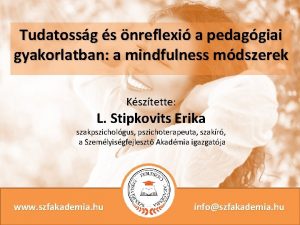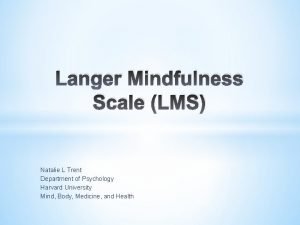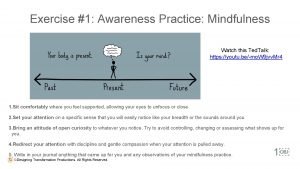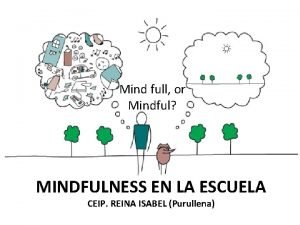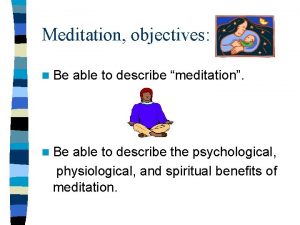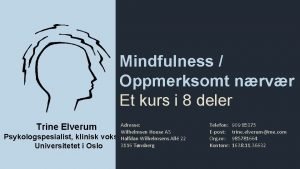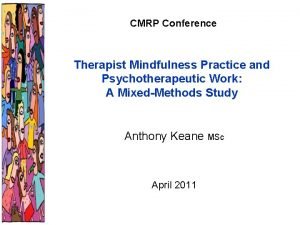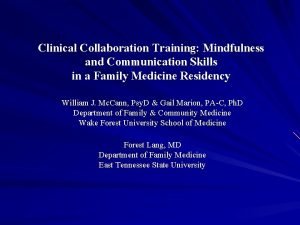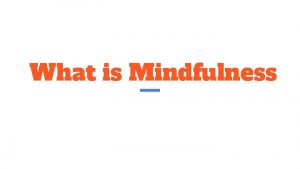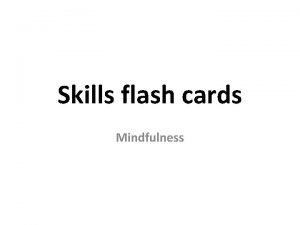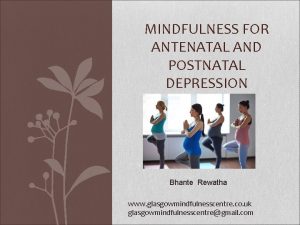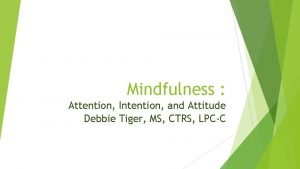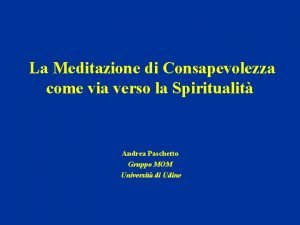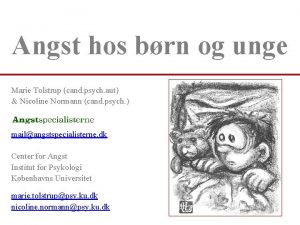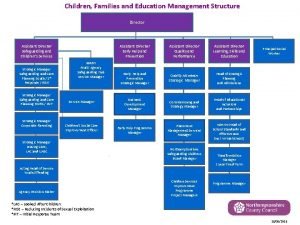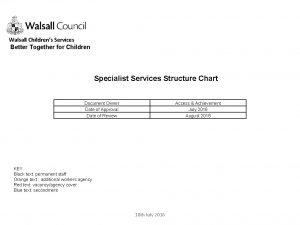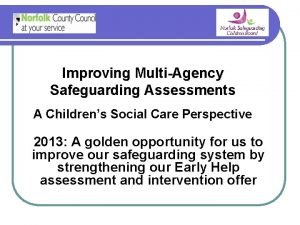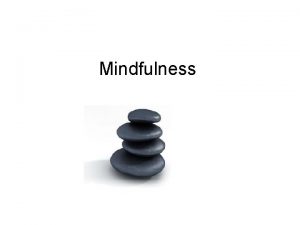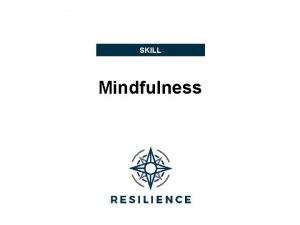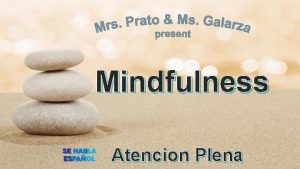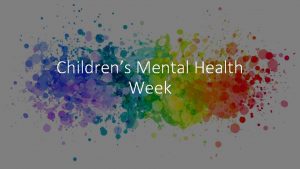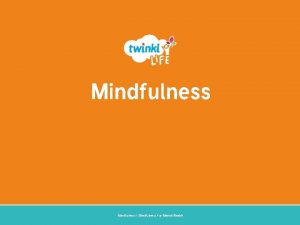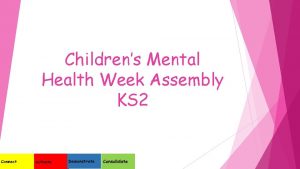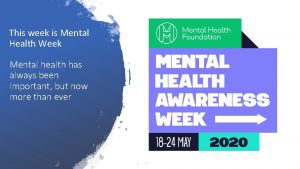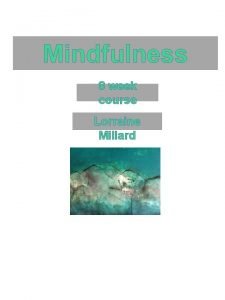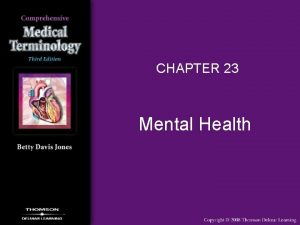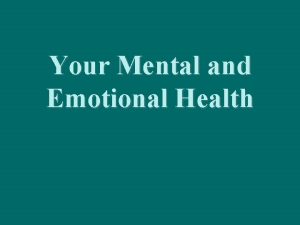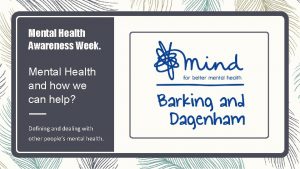Mindfulness Childrens Mental Health Week Mindfulness Childrens Mental



























- Slides: 27

Mindfulness Children’s Mental Health Week Mindfulness | Children’s Mental Health Week


Aim • I can explain what mindfulness is. Success Criteria 1 Lorem ipsum dolor wanders. sit amet, consectetur adipiscing elit. • Statement I can recognise when my mind • • Statement I can label 2 my thoughts. • Sub statement

The Big Questions

The Big Questions What is Mindfulness? Is it easy or difficult to pay attention? What happens when we do not pay attention? Talk about these questions with a partner. Now share your thoughts with the class. What a lot of interesting ideas! Now let’s explore these a little more.

Reconnecting

Stressed, Sad, Anxious or Angry: Mindfulness and Mental Health Today we are going to be exploring a new subject. This subject is called Mindfulness. We are going to use mindfulness to help us understand how we are feeling and how we can help ourselves be more settled and calm. Understanding how we are feeling and how this can affect our behaviour is very important. It can help us feel more calm and settled. It can also help us manage and live with our more difficult emotions such as: feeling stressed, feeling anxious, feeling sad, feeling angry. There are no ‘good’ or ‘bad’ feelings!

Stressed, Sad, Anxious or Angry: Mindfulness and Mental Health Feeling this way from time to time is perfectly OK. There is nothing to be afraid of or ashamed of in feeling stressed, anxious, sad or angry. Everyone experiences these emotions – friends, family, parents and even teachers! These feelings are often labelled as ‘bad’ but there is no such thing as a bad feeling or emotion. Worries we have tend to come from our reaction to the emotion or feeling.

Stressed, Sad, Anxious or Angry: Mindfulness and Mental Health If we do not understand these emotions and how they can affect us, they can affect our mood and our mental health. Sometimes, our more challenging emotions can take over our life and we can find ourselves feeling very sad and unhappy. Mindfulness teaches us to be aware of, and understand our emotions. By practicing mindfulness when we experience challenging emotions, it can help us to let them go. This. There helps are us to nobe ‘good’ moreor happy ‘bad’ and feelings! content.

Exploring

What is Mindfulness? Mindfulness is a practice and discipline that allows us to explore our experience. Mindfulness is a form of training where we train ourselves to be focused, settled and calm. We learn to focus on our thoughts, feelings and physical feelings and see how they shape or affect our mood and behaviour. In mindfulness we are learning to pay attention and to notice when our mind has wandered off into thinking and day dreaming. Psychologists have found that we spend nearly half of our day not focused but daydreaming!

The Scattered Mind Our minds can be full of thoughts. It is OK to be scattered but it can make it very difficult to concentrate on one thing. Just for a moment, close your eyes Now open your eyes. What happened and imagine yourself enjoying your to your concentration? favourite activity. Allow the memories of doing this activity to appear. Now try and keep This you lack to of think about different things: focusing on this activity as I ask If you feel You have homework to do. focus is often happy to, share described as The your thoughts Your brother, sister or You need. Scattered to tidy Mind with the class. friend is doing something in mindfulness. your bedroom. that annoys you.

The Scattered Mind Having a scattered mind is OK. Our minds will wander, we will get distracted. However, a scattered mind affects more than our concentration. It can also affect how we are feeling. The psychologists who discovered that we spend nearly half of our days daydreaming, found that when our minds are scattered, we are more likely to feel stressed, anxious, sad or angry. This is because instead of experiencing our life as it is, we get caught up in thinking, worrying and being anxious about how things were or how they could be.

The Scattered Mind Over time this can affect our mood, our behaviour and our mental health. Learning to settle the scattered mind is a key part of learning to be calmer and happier. Through mindful meditation practices, we can train our mind to be more calm. We can try this now with the Breath and Thoughts Meditation.

Guided Practice

Breathing and Thinking Consolidating Reflecting

Consolidating

Thought Clouds Practicing mindfulness can be difficult. Sometimes, no matter how hard we try to settle the mind, we keep getting caught up in our thoughts. Instead of just noticing that we are thinking, our mind takes over and before we know it, we are stuck in a whirlwind of thoughts about all kinds of things. Thoughts become more thoughts and they become more thoughts! Soon we can feel like all we have are thoughts! To help us be more mindful, we can use the Thought Clouds to help us recognise and let go of thoughts. This is a very important part of being mindful. We are not ignoring our thoughts, but we are not being carried away by them either.

Just stop for a few moments. Set aside five minutes to stop and sit, stand or lay still. Close your eyes if this helps. Thought Clouds Now, just focus on your breathing. Feel the sensations of breathing. Look at the thought for a few moments and then, ‘let it go’ (you can even gently move the card away from you or drop it). Each time you notice a thought, say to yourself (either out loud or silently in your head) ‘I am thinking’, open your eyes and then write thought on one of the clouds. Go back to focusing on breathing.

Thought Clouds Each time you notice a thought, say to yourself (either out loud or silently in your head) ‘I am thinking’, open your eyes and then write thought on one of the clouds. Look at the thought for a few moments and then, ‘let it go’ (you can even gently move the card away from you or drop it). Keep doing this for a few minutes before opening your eyes and getting back to your day.

Reflecting

Sharing our Experiences Now let’s share our experiences of the activities we have done today. Take a moment to think about your answers to these questions. What did you notice? Did the mind wander? What happened to your thoughts when you labelled them? Now if you feel happy to, please share your answers to each question with the class.

The Big Questions

The Big Questions What is Mindfulness? Is it easy or difficult to pay attention? What happens when we do not pay attention? Talk about these questions with a partner. What is the most useful thing you have learnt today?

Mindfulness Helps to Settle the mind. The mind is naturally scattered. Learning to focus the mind can help us to settle and feel calm. This can help us to better understand our feelings and emotions. It can help us to not get so distracted by our thoughts. Practicing mindfulness can have a positive impact on how we feel and on our mental health.

Aim • I can explain what mindfulness is. Success Criteria 1 Lorem ipsum dolor wanders. sit amet, consectetur adipiscing elit. • Statement I can recognise when my mind • • Statement I can label 2 my thoughts. • Sub statement

 Mental health and mental illness chapter 20
Mental health and mental illness chapter 20 Mental health jeopardy
Mental health jeopardy Week by week plans for documenting children's development
Week by week plans for documenting children's development Yun xin
Yun xin Brainpop precision and accuracy quiz answers
Brainpop precision and accuracy quiz answers Mindfulness gyerekeknek
Mindfulness gyerekeknek Langer mindfulness scale
Langer mindfulness scale Mindfullness ted talk
Mindfullness ted talk Mind full
Mind full Mindfulness objectives
Mindfulness objectives Felix compen
Felix compen Mindfulness definisjon
Mindfulness definisjon Mindfulness
Mindfulness Mindfulness for collaboration
Mindfulness for collaboration Mindfulness circle
Mindfulness circle Bodily sensations examples
Bodily sensations examples Dhamma
Dhamma Attention intention attitude
Attention intention attitude Franco fabbro
Franco fabbro Detached mindfulness øvelser
Detached mindfulness øvelser Moli texas children's hospital
Moli texas children's hospital The christian childrens fund
The christian childrens fund Childrens services
Childrens services Walsall childrens services
Walsall childrens services Levine childrens
Levine childrens 23 april international children's day turkey
23 april international children's day turkey Kirklees safeguarding childrens board
Kirklees safeguarding childrens board World literature quiz 22
World literature quiz 22





